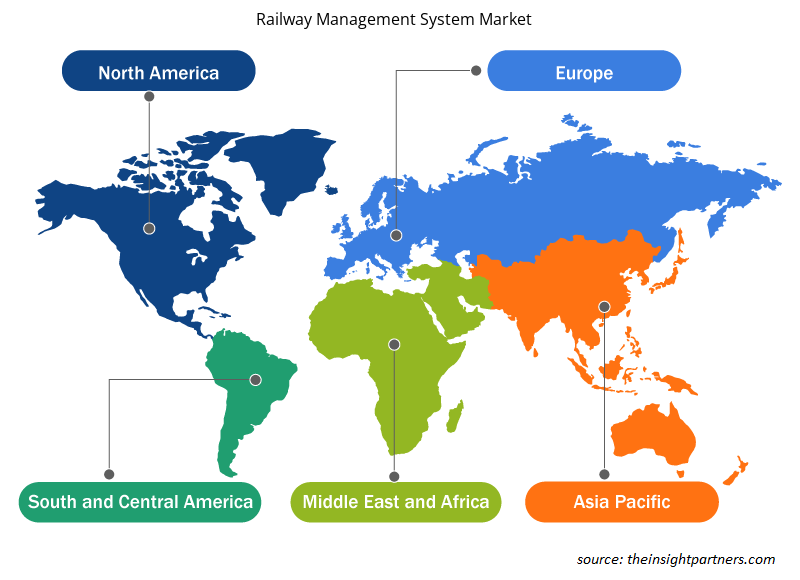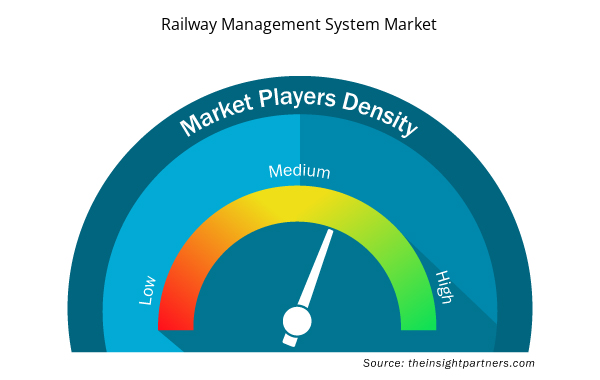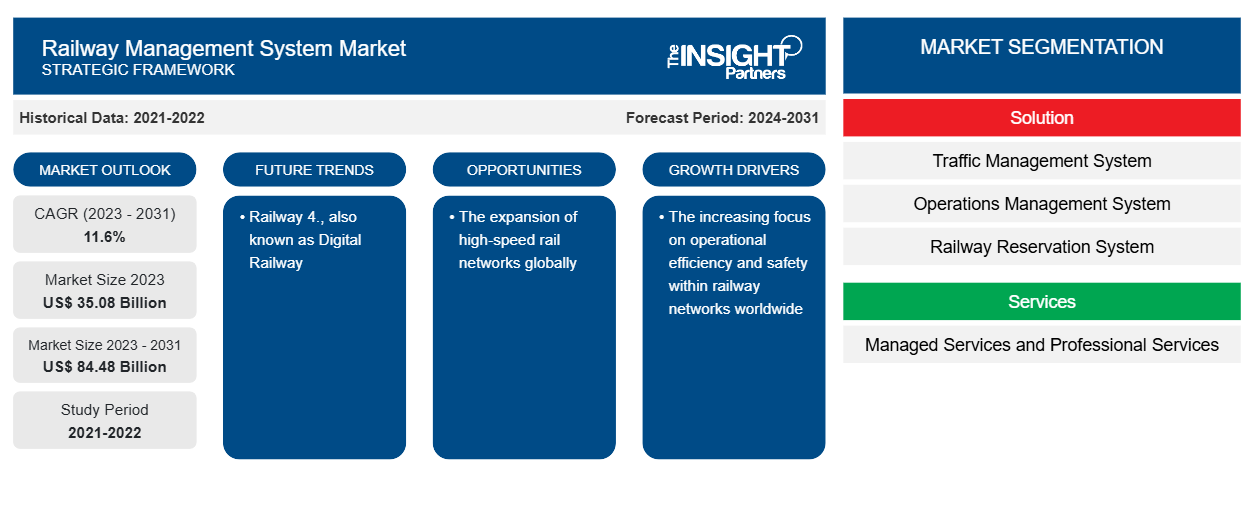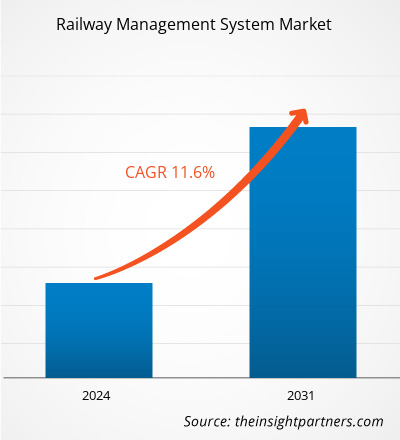Der Markt für Eisenbahnmanagementsysteme soll von 35,08 Milliarden US-Dollar im Jahr 2023 auf 84,48 Milliarden US-Dollar im Jahr 2031 anwachsen. Der Markt soll zwischen 2023 und 2031 eine durchschnittliche jährliche Wachstumsrate (CAGR) von 11,6 % verzeichnen. Railway 4.0, auch bekannt als Digital Railway, wird voraussichtlich weiterhin ein wichtiger Markttrend für Eisenbahnmanagementsysteme bleiben.
Marktanalyse für Eisenbahnmanagementsysteme
Der Markt für Eisenbahnmanagementsysteme wächst aufgrund verschiedener Trends in der Infrastrukturentwicklung und der Transporttechnologie. Diese Systeme konzentrieren sich auf Betriebseffizienz, verbesserte Sicherheit und Fahrgasterlebnis durch Funktionen wie Echtzeitüberwachung und vorausschauende Wartung. Mehrere Technologien treiben den Markt an, darunter KI (künstliche Intelligenz), IoT (Internet der Dinge) und Cloud-Computing, die eine Fernoptimierung und -verwaltung des Eisenbahnbetriebs ermöglichen. Insgesamt wächst und expandiert der Markt für Eisenbahnmanagementsysteme weltweit, angetrieben von der Notwendigkeit, die Effizienz, Sicherheit und Nachhaltigkeit der Eisenbahn zu verbessern.
Marktübersicht für Eisenbahnmanagementsysteme
Ein Eisenbahnmanagementsystem umfasst mehrere Prozesse und Technologien zur effizienten Verwaltung und zum Betrieb von Eisenbahnnetzen. Es umfasst Komponenten wie Frachtmanagement, Ticketsysteme , Fahrgastinformationen, Zugfahrpläne, Wartungsplanung und Sicherheitsüberwachung. Das System nutzt fortschrittliche Technologien wie GPS, Kommunikationsnetzwerke und IoT-Sensoren, um eine optimierte Routenplanung, die Gewährleistung der Sicherheit und die Echtzeitverfolgung von Zügen zu ermöglichen. Der Fahrgastservice wird durch Sitzplatzreservierung, Online-Ticketbuchung und Echtzeit-Updates der Zugfahrpläne verbessert. Darüber hinaus werden Wartungsaktivitäten rationalisiert und Ausfallzeiten reduziert sowie die allgemeine Betriebseffizienz durch den Einsatz von Techniken zur vorausschauenden Wartung verbessert.
Passen Sie diesen Bericht Ihren Anforderungen an
Sie erhalten kostenlose Anpassungen an jedem Bericht, einschließlich Teilen dieses Berichts oder einer Analyse auf Länderebene, eines Excel-Datenpakets sowie tolle Angebote und Rabatte für Start-ups und Universitäten.
- Holen Sie sich die wichtigsten Markttrends aus diesem Bericht.Dieses KOSTENLOSE Beispiel umfasst eine Datenanalyse von Markttrends bis hin zu Schätzungen und Prognosen.
Markttreiber und Chancen für Eisenbahnmanagementsysteme
Der zunehmende Fokus auf Betriebseffizienz und Sicherheit in Eisenbahnnetzen weltweit
Angesichts des wachsenden Passagier- und Frachtaufkommens greifen Bahnbetreiber auf fortschrittliche Managementsysteme zurück, um Zugfahrpläne, Gleiswartung und die Gesamtleistung des Netzes zu optimieren. Diese Systeme nutzen Technologien wie IoT-Sensoren, prädiktive Analysen und Echtzeitüberwachung, um die Sicherheit zu erhöhen, Verspätungen zu minimieren und Betriebskosten zu senken. Durch die Verbesserung von Effizienz und Zuverlässigkeit tragen Bahnmanagementsysteme dazu bei, die steigenden Kundenerwartungen und gesetzlichen Standards zu erfüllen.IoT sensors, predictive analytics, and real-time monitoring to enhance safety, minimize delays, and reduce operational costs. By improving efficiency and reliability, railway management systems help meet rising customer expectations and regulatory standards.
Der Ausbau der Hochgeschwindigkeitsnetze weltweit
Viele Länder investieren in die Modernisierung ihrer Schieneninfrastruktur, um Hochgeschwindigkeitszüge zu unterstützen und schnellere und nachhaltigere Transportmöglichkeiten anzubieten. Dieser Trend schafft eine erhebliche Nachfrage nach fortschrittlichen Eisenbahnmanagementlösungen, die in der Lage sind, komplexe Abläufe bei höheren Geschwindigkeiten zu verwalten und eine nahtlose Konnektivität zwischen verschiedenen Schienennetzen sicherzustellen. Da Hochgeschwindigkeitsbahnprojekte weiter ausgebaut werden, steht der Markt für innovative Eisenbahnmanagementsysteme vor einem erheblichen Wachstum. Daher wird erwartet, dass der Ausbau der Hochgeschwindigkeitsbahnnetze weltweit den Akteuren auf dem Markt für Eisenbahnmanagementsysteme im Prognosezeitraum neue Möglichkeiten bietet.
Segmentierungsanalyse des Marktberichts zum Eisenbahnmanagementsystem
Wichtige Segmente, die zur Ableitung der Marktanalyse für Eisenbahnmanagementsysteme beigetragen haben, sind Lösung und Bereitstellungstyp.
- Basierend auf der Lösung ist der Markt für Eisenbahnmanagementsysteme in Verkehrsmanagementsysteme, Betriebsmanagementsysteme, Eisenbahnreservierungssysteme, Fahrgastinformationssysteme, Wartungsmanagementsysteme und andere unterteilt.
- Basierend auf den Diensten ist der Markt für Eisenbahnmanagementsysteme in Managed Services und Professional Services segmentiert.
- Nach Bereitstellungstyp ist der Markt in On-Premise und Cloud segmentiert. Das Cloud-Segment hatte im Jahr 2023 einen größeren Marktanteil.
Marktanteilsanalyse für Eisenbahnmanagementsysteme nach Geografie
Der geografische Umfang des Marktberichts zum Eisenbahnmanagementsystem ist hauptsächlich in fünf Regionen unterteilt: Nordamerika, Asien-Pazifik, Europa, Naher Osten und Afrika sowie Südamerika/Süd- und Mittelamerika. In Bezug auf den Umsatz hatte Europa den größten Marktanteil im Bereich Eisenbahnmanagementsysteme. In Europa treiben etablierte Eisenbahnnetze und ein Fokus auf Effizienz die Nachfrage nach fortschrittlichen Managementsystemen voran, die Sicherheit, Pünktlichkeit und das Fahrgasterlebnis verbessern. Länder wie Deutschland und Frankreich sind führend bei der Einführung modernster Technologien für Zugsteuerung, Signalisierung und Wartung.
Regionale Einblicke in den Markt für Eisenbahnmanagementsysteme
Die regionalen Trends und Faktoren, die den Markt für Eisenbahnmanagementsysteme im Prognosezeitraum beeinflussen, wurden von den Analysten von Insight Partners ausführlich erläutert. In diesem Abschnitt werden auch die Marktsegmente und die Geografie von Eisenbahnmanagementsystemen in Nordamerika, Europa, im asiatisch-pazifischen Raum, im Nahen Osten und Afrika sowie in Süd- und Mittelamerika erörtert.

- Get the Regional Specific Data for Railway Management System Market
Railway Management System Market Report Scope
| Report Attribute | Details |
|---|---|
| Market size in 2023 | US$ 35.08 Billion |
| Market Size by 2031 | US$ 84.48 Billion |
| Global CAGR (2023 - 2031) | 11.6% |
| Historical Data | 2021-2022 |
| Forecast period | 2024-2031 |
| Segments Covered | By Solution
|
| Regions and Countries Covered | North America
|
| Market leaders and key company profiles |
|
Railway Management System Market Players Density: Understanding Its Impact on Business Dynamics
The Railway Management System Market market is growing rapidly, driven by increasing end-user demand due to factors such as evolving consumer preferences, technological advancements, and greater awareness of the product's benefits. As demand rises, businesses are expanding their offerings, innovating to meet consumer needs, and capitalizing on emerging trends, which further fuels market growth.
Market players density refers to the distribution of firms or companies operating within a particular market or industry. It indicates how many competitors (market players) are present in a given market space relative to its size or total market value.
Major Companies operating in the Railway Management System Market are:
- Bombardier, Inc.
- DXC Technology Company
- EKE-Electronics Ltd
- General Electric Company
- Hitachi, Ltd.
- Huawei Technologies Co.; Ltd.
Disclaimer: The companies listed above are not ranked in any particular order.

- Get the Railway Management System Market top key players overview
Railway Management System Market News and Recent Developments
The railway management system market is evaluated by gathering qualitative and quantitative data post primary and secondary research, which includes important corporate publications, association data, and databases. The following is a list of developments in the market for speech and language disorders and strategies:
- In August 2023, Toast, the all-in-one technology platform built for restaurants, announced the launch of Toast Catering & Events, a new product fully integrated with the Toast point-of-sale (POS) to help restaurants seamlessly manage large catering orders and event planning. Toast Catering & Events supports customizable banquet event orders (BEO), fulfillment tools, and lead management functionality. (Source: Toast, Press Release)
- Im Juni 2021 kündigte FoodStorm, der weltweit führende Anbieter von Catering-Software, die Einführung seines FoodStorm Kiosk an, eines physischen Selbstbedienungskiosks, an dem Kunden im Geschäft Catering, Fertiggerichte, Feinkost und Backwaren über ein verwaltetes Backend bestellen können. (Quelle: FoodStorm, Pressemitteilung)
Marktbericht zum Eisenbahnmanagementsystem – Umfang und Ergebnisse
Der Bericht „Marktgröße und Prognose für Eisenbahnmanagementsysteme (2023–2031)“ bietet eine detaillierte Analyse des Marktes, die die folgenden Bereiche abdeckt:
- Marktgröße und Prognose auf globaler, regionaler und Länderebene für alle wichtigen Marktsegmente, die im Rahmen des Projekts abgedeckt sind
- Marktdynamik wie Treiber, Beschränkungen und wichtige Chancen
- Wichtige Zukunftstrends
- Detaillierte PEST/Porters Five Forces- und SWOT-Analyse
- Globale und regionale Marktanalyse mit wichtigen Markttrends, wichtigen Akteuren, Vorschriften und aktuellen Marktentwicklungen
- Branchenlandschaft und Wettbewerbsanalyse, einschließlich Marktkonzentration, Heatmap-Analyse, prominenten Akteuren und aktuellen Entwicklungen
- Detaillierte Firmenprofile
- Historische Analyse (2 Jahre), Basisjahr, Prognose (7 Jahre) mit CAGR
- PEST- und SWOT-Analyse
- Marktgröße Wert/Volumen – Global, Regional, Land
- Branche und Wettbewerbsumfeld
- Excel-Datensatz


- Virtual Pipeline Systems Market
- Lyophilization Services for Biopharmaceuticals Market
- Electronic Shelf Label Market
- Queue Management System Market
- Mail Order Pharmacy Market
- Small Molecule Drug Discovery Market
- Batter and Breader Premixes Market
- Joint Pain Injection Market
- Thermal Energy Storage Market
- Employment Screening Services Market

Report Coverage
Revenue forecast, Company Analysis, Industry landscape, Growth factors, and Trends

Segment Covered
This text is related
to segments covered.

Regional Scope
North America, Europe, Asia Pacific, Middle East & Africa, South & Central America

Country Scope
This text is related
to country scope.
Häufig gestellte Fragen
The global railway management system market is expected to reach US$ 84.48 billion by 2031.
The key players holding majority shares in the global railway management system market are Bombardier, Inc., DXC Technology Company, EKE-Electronics Ltd, General Electric Company, and Hitachi, Ltd.
Railway 4.0, also known as Digital Railway is anticipated to play a significant role in the global railway management system market in the coming years.
The increasing focus on operational efficiency and safety within railway networks worldwide and the expansion of high-speed rail networks globally are the major factors that propel the global railway management system market.
The global railway management system market was estimated to be US$ 35.08 billion in 2023 and is expected to grow at a CAGR of 11.6 % during the forecast period 2023 - 2031.
Trends and growth analysis reports related to Technology, Media and Telecommunications : READ MORE..
The Insight Partners performs research in 4 major stages: Data Collection & Secondary Research, Primary Research, Data Analysis and Data Triangulation & Final Review.
- Data Collection and Secondary Research:
As a market research and consulting firm operating from a decade, we have published and advised several client across the globe. First step for any study will start with an assessment of currently available data and insights from existing reports. Further, historical and current market information is collected from Investor Presentations, Annual Reports, SEC Filings, etc., and other information related to company’s performance and market positioning are gathered from Paid Databases (Factiva, Hoovers, and Reuters) and various other publications available in public domain.
Several associations trade associates, technical forums, institutes, societies and organization are accessed to gain technical as well as market related insights through their publications such as research papers, blogs and press releases related to the studies are referred to get cues about the market. Further, white papers, journals, magazines, and other news articles published in last 3 years are scrutinized and analyzed to understand the current market trends.
- Primary Research:
The primarily interview analysis comprise of data obtained from industry participants interview and answers to survey questions gathered by in-house primary team.
For primary research, interviews are conducted with industry experts/CEOs/Marketing Managers/VPs/Subject Matter Experts from both demand and supply side to get a 360-degree view of the market. The primary team conducts several interviews based on the complexity of the markets to understand the various market trends and dynamics which makes research more credible and precise.
A typical research interview fulfils the following functions:
- Provides first-hand information on the market size, market trends, growth trends, competitive landscape, and outlook
- Validates and strengthens in-house secondary research findings
- Develops the analysis team’s expertise and market understanding
Primary research involves email interactions and telephone interviews for each market, category, segment, and sub-segment across geographies. The participants who typically take part in such a process include, but are not limited to:
- Industry participants: VPs, business development managers, market intelligence managers and national sales managers
- Outside experts: Valuation experts, research analysts and key opinion leaders specializing in the electronics and semiconductor industry.
Below is the breakup of our primary respondents by company, designation, and region:

Once we receive the confirmation from primary research sources or primary respondents, we finalize the base year market estimation and forecast the data as per the macroeconomic and microeconomic factors assessed during data collection.
- Data Analysis:
Once data is validated through both secondary as well as primary respondents, we finalize the market estimations by hypothesis formulation and factor analysis at regional and country level.
- Macro-Economic Factor Analysis:
We analyse macroeconomic indicators such the gross domestic product (GDP), increase in the demand for goods and services across industries, technological advancement, regional economic growth, governmental policies, the influence of COVID-19, PEST analysis, and other aspects. This analysis aids in setting benchmarks for various nations/regions and approximating market splits. Additionally, the general trend of the aforementioned components aid in determining the market's development possibilities.
- Country Level Data:
Various factors that are especially aligned to the country are taken into account to determine the market size for a certain area and country, including the presence of vendors, such as headquarters and offices, the country's GDP, demand patterns, and industry growth. To comprehend the market dynamics for the nation, a number of growth variables, inhibitors, application areas, and current market trends are researched. The aforementioned elements aid in determining the country's overall market's growth potential.
- Company Profile:
The “Table of Contents” is formulated by listing and analyzing more than 25 - 30 companies operating in the market ecosystem across geographies. However, we profile only 10 companies as a standard practice in our syndicate reports. These 10 companies comprise leading, emerging, and regional players. Nonetheless, our analysis is not restricted to the 10 listed companies, we also analyze other companies present in the market to develop a holistic view and understand the prevailing trends. The “Company Profiles” section in the report covers key facts, business description, products & services, financial information, SWOT analysis, and key developments. The financial information presented is extracted from the annual reports and official documents of the publicly listed companies. Upon collecting the information for the sections of respective companies, we verify them via various primary sources and then compile the data in respective company profiles. The company level information helps us in deriving the base number as well as in forecasting the market size.
- Developing Base Number:
Aggregation of sales statistics (2020-2022) and macro-economic factor, and other secondary and primary research insights are utilized to arrive at base number and related market shares for 2022. The data gaps are identified in this step and relevant market data is analyzed, collected from paid primary interviews or databases. On finalizing the base year market size, forecasts are developed on the basis of macro-economic, industry and market growth factors and company level analysis.
- Data Triangulation and Final Review:
The market findings and base year market size calculations are validated from supply as well as demand side. Demand side validations are based on macro-economic factor analysis and benchmarks for respective regions and countries. In case of supply side validations, revenues of major companies are estimated (in case not available) based on industry benchmark, approximate number of employees, product portfolio, and primary interviews revenues are gathered. Further revenue from target product/service segment is assessed to avoid overshooting of market statistics. In case of heavy deviations between supply and demand side values, all thes steps are repeated to achieve synchronization.
We follow an iterative model, wherein we share our research findings with Subject Matter Experts (SME’s) and Key Opinion Leaders (KOLs) until consensus view of the market is not formulated – this model negates any drastic deviation in the opinions of experts. Only validated and universally acceptable research findings are quoted in our reports.
We have important check points that we use to validate our research findings – which we call – data triangulation, where we validate the information, we generate from secondary sources with primary interviews and then we re-validate with our internal data bases and Subject matter experts. This comprehensive model enables us to deliver high quality, reliable data in shortest possible time.


 Holen Sie sich ein kostenloses Muster für diesen Bericht
Holen Sie sich ein kostenloses Muster für diesen Bericht